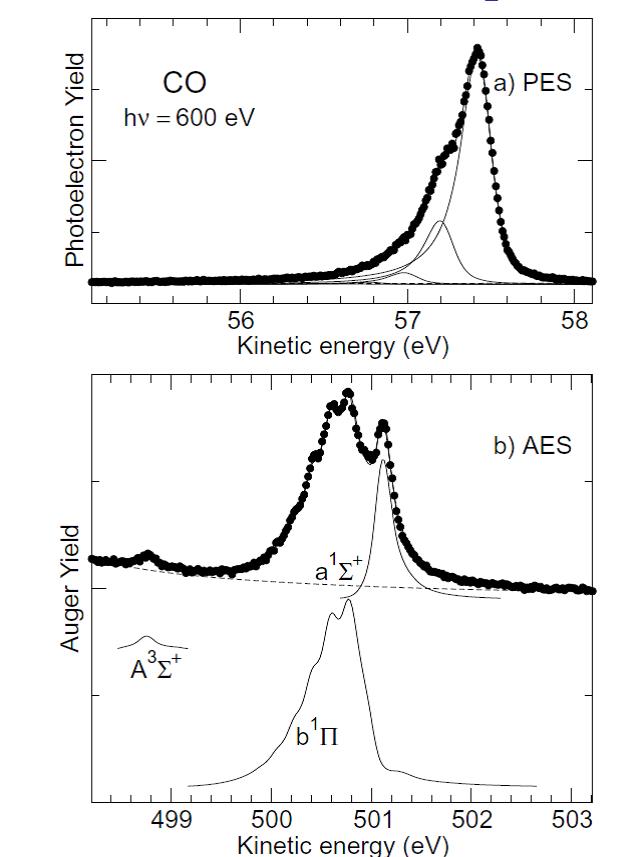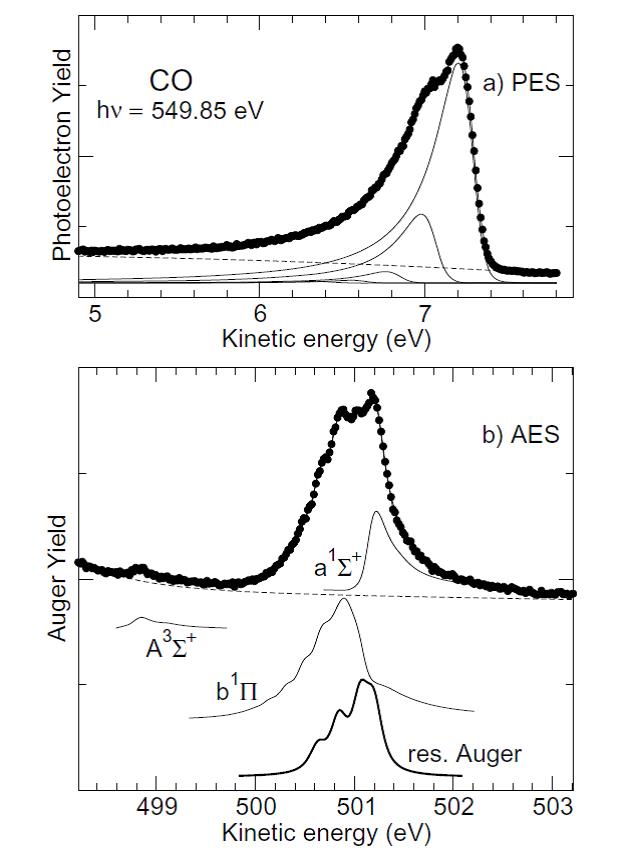Auger spectroscopy and photoemission spectroscopy experiments carried out at SPring8 and SOLEIL help deciphering the electronic behavior of the ionised CO molecule.
The results, published in New Journal of Physics by scientists from Swedish, Japanese, German and French laboratories, show that such analyses will now make possible to study highly excited states of molecular ions which overlap with features from normal Auger spectra and which have not yet been observed with photoelectron spectroscopy directly.
When an isolated atom or molecule is exposed to monochromatic radiation of high enough frequency, a core electron can be excited to a suitable empty state or ejected in the continuum.
While the first process (photoexcitation) is resonant, meaning that it takes place at a definite photon energy value corresponding to a specific transition, and usually occurs below a photoionization threshold, the second one (photoionization) takes place for any photon energy value above the ionization threshold. However, a wealth of resonant phenomena can occur also in the photoionization continuum. The most commonly studied continuum resonances are the so-called shape resonances, which are one-electron effects in the continua, just above core-level ionization thresholds. They originate from a potential barrier able to temporarily trap a photoelectron which eventually tunnels through it and escapes. Another type of continuum resonances are doubly excited states, which can be present above an ionization threshold and frequently overlap with shape resonances. They decay via resonant Auger processes, with one electron filling the core hole and another electron being ejected, while the core hole created by photoionization decays via normal Auger processes.
Two synchrotrons for a combination of techniques
In this work, the scientists have performed a very detailed analysis of the spectra in the normal Auger region of CO subsequent to O 1s photoionization in the energy region containing a shape resonance. As a result of this approach, they were able to separate spectral features overlapping in kinetic energy into contributions which originate from normal and resonant Auger processes. In addition, they were able to identify the initial doubly excited and the final ionized state of the resonant Auger process. The final state turned out to be a highly excited one which is energetically above the energy region studied with photoelectron spectroscopy so far.
A first series of experiments concerning the Auger spectra has been carried out on the soft x-ray photochemistry beamline 27SU at SPring-8 in Japan.
A second series of experiments, including the repetition of the Auger electron spectra and the measurement of complementary high-resolution O 1s photoelectron spectra, was carried out on the soft x-ray beamline PLEIADES at SOLEIL.
Figures 1 and 2 show O 1s photoelectron and Auger spectra for CO taken at a photon energy of 600 eV (Fig.1) and 550 eV (Fig.2). The main difference in the O 1s photoelectron spectra is a variation of the lineshape cause by post-collision interaction (PCI), which is due to the fact that the generally faster Auger electron overtakes the slower photoelectron depending on the photon energy at different distances from the molecular ion. In the Auger spectra, beside the variation in lineshape due to the change in the photoelectron spectra, the main difference is the presence of an additional component, labeled res. Auger, in the spectrum taken at 550 eV.

Figure 1 : (a) Photoelectron and (b) Auger spectra recorded at a photon energy of 600 eV. In both spectra, the solid lines through the data points represent the fit results and the dashed lines indicate the background. In the PES the subspectra represent the different vibrational substates of the core-ionized state, while in the AES the subspectra indicate the vibrational progressions of the Auger decays to the final states a1S+, b1P and A3S+

Figure 2 : (a) Photoelectron and (b) Auger spectra recorded at a photon energy of 549.85 eV. The bold solid subspectrum in the AES represents the contributions of the resonant Auger decays of the doubly excited state.
The researchers clarify the nature of the extra feature on the ground of their careful fitting procedure, of its angular behavior (not shown), and of energetic arguments. They assign it as deriving from the decay of a doubly excited state embedded in the continuum to a final state with two valence holes and one excited electron. In more detail, the electronic structure of such final state is 4s−2 3ls.
Up to now, resonant Auger transitions were most frequently studied in the kinetic energy regime below that of the normal Auger transitions. From this present work, the conclusion is that, by combining state-of-the-art experimental resolution and advanced fitting procedures, it is possible to disentangle a complex decay process following photoexcitation to neutral doubly excited states happening to overlap with a shape resonance.
Such analyses will make possible to study highly excited states of molecular ions which overlap with features from normal Auger spectra and which have not yet been observed with photoelectron spectroscopy directly.
